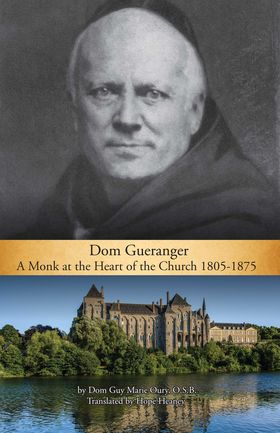Categories
Information
By Dom Guy Marie Oury, O.S.B. Translated by Hope Heaney - PB 440 pages
After the devastation of the French Revolution, the first abbot of Solesmes launched the ecclesial movement which invited
all Christians to experience a spiritual participation in the liturgy, “the initial source of the true Christian spirit.” Dom
Guéranger worked to instill knowledge and love for the origins of Christianity and the Church of the Fathers, thus preparing a
fertile and fruitful “return to the sources” for the entire Church.
For more about Dom Guéranger, click here!
He defined himself as “a man of the spiritual order,” opposed in every way to the naturalism of his era. It seemed to him, and
rightly so, that God’s mystery could not be treated as were the human sciences—He transcended them. Throughout his entire
life, Dom Guéranger never stopped protesting against “the diminished truths” mentioned in Psalm 11:2.
TABLE OF CONTENTS
Preface
Introduction
Chapter 1: Sablé During the Empire and Restoration
Chapter 2: Adolescent Years in Angers
Chapter 3: The Seminarian from Le Mans
Chapter 4: Secretary to Bishop De La Myre-Mory
Chapter 5: A Go-it-Alone Mennaisian
Chapter 6: Administrator for the Foreign Missions Society
Chapter 7: The Three Glorious Days: the Revolution of 1830
Chapter 8: The Young Priest from Le Mans
Chapter 9: The Priory of Solesmes
Chapter 10: Seeking Candidates and Resources
Chapter 11: Final Preparations
Chapter 12: July 11, 1833
Chapter 13: A First Novitiate Under a Novice Prior
Chapter 14: Initial Projects, Initial Guests
Chapter 15: The Crisis of 1836
Chapter 16: First Trip to Rome
Chapter 17: Approval from Rome
Chapter 18: Bishop Bouvier and the Abbey of Solesmes
Chapter 19: The Young Abbot Amidst his Monks
Chapter 20: The Liturgical Institutions
Chapter 21: The Liturgical Year
Chapter 22: The Second Trip to Rome
Chapter 23: The Fortunes And Misfortunes of the Saint-Germain Priory in Paris
Chapter 24: Catastrophe
Chapter 25: Triennial Abbatial Appointment Under Episcopal Control
Chapter 26: In The Upheaval: a Father Amidst his Monks
Chapter 27: Revolution in France and in Rome
Chapter 28: Friends and Guests of the Monastery
Chapter 29: Plans for New Foundations
Chapter 30: Third Trip to Rome (1851-1852)
Chapter 31: Naturalism and Liberalism
Chapter 32: The Failure of the Acey Foundation
Chapter 33: Fourth Trip to Rome (1856)
Chapter 34: In Defense of Mysticism and Philosophical Naturalism
Chapter 35: Dom Gueranger and the English Congregation
Chapter 36: Dom Couturier and Rules for the Novitiate
Chapter 37: The Spiritual Teachings of Dom Guéranger
Chapter 38: Dom Guéranger: Spiritual Director
Chapter 39: Dom Guéranger and the Congregation of Beuron
Chapter 40: The Foundation of Marseilles
Chapter 41: The Foundation of Sainte-Cécile of Solesmes
Chapter 42: The Restoration of Gregorian Chant
Chapter 43: The First Vatican Council
Chapter 44: Solesmes in the Franco-Prussian War
Chapter 45: An Abbess for Sainte-Cécile
Chapter 46: Final Journeys
Chapter 47: The Last Road
Preface
The abbot of Solesmes was a man of a great and single idea. He had from the start the genial intuition of his mission, and he devoted himself entirely to it: that of restoring to our disinherited age all the scattered treasures of the thousand-year tradition of Christianity, and above all the forgotten riches of antiquity that the Church preserves in her liturgy. Such was the luminous star that guided him in all his ways. And he envisaged this ideal in all its aspects: … the study and the love of liturgical institutions; the pastoral value of the liturgical year and its ever varied teachings; the doctrinal foundations of this theological locus of first order; the treasures of asceticism and of mysticism which the liturgical seasons and the lives of the Saints bring us every day. In sum, Dom Guéranger placed himself from the beginning at the center of the temple, and he contemplated its every part and all its elements: he is the unequaled liturgist.
Thus spoke Dom Lambert Beauduin, a Belgian monk, a main proponent in the early twentieth century of what has been called the “liturgical movement.” He and others wanted to continue what Dom Guéranger had begun in France in the preceding century. In fact, as a recent historian has pointed out, the very expression “liturgical movement” was first used by Guéranger, whose influence has proved to be so great even up until our time.
Many Catholics know Dom Guéranger as the author of The Liturgical Year, a guide to the Church’s liturgy that has helped them understand and appreciate the riches of the Roman Catholic liturgy. Many have also heard of the work accomplished by his monks at the Solesmes abbey in France for the restoration of Gregorian chant. We at Clear Creek Abbey belong to the Congregation of Solesmes and so partake of that rich and living heritage.
What some may not know is that this incomparable liturgist was also a saintly monk, whose cause for beatification has begun in the diocese of Le Mans, France, where he lived and died. He is now given the title of “Servant of God.”
Dom Guéranger was the friend of saints and of popes. Pope Blessed Pius IX, in his Letter of April 10, 1876, wrote, along with many other high praises of Dom Guéranger, the following words:
By his virtue, piety, zeal, knowledge, and by the work of a lifetime, he showed himself to be a true disciple of Saint Benedict and a perfect monk.
A year earlier the same Pope, following the death of Dom Guéranger, had reminded the Church that, both on the occasion of the definition of the Immaculate Conception (1854) and on that of Papal Infallibility (1870), Guéranger had contributed written works “full of faith and sacred learning” that served to uphold the Holy See in making these ex cathedra pronouncements.
Dom Guéranger has his critics, nevertheless: such seems to be the lot of anyone who exercises a widespread influence in the world or in the Church. There is no need here to delve into the specific attacks against the abbot of Solesmes. It will suffice to say that theologians often forget that it is not fair to judge those of a different era with the prejudices of our own. Dom Guéranger was certainly a man of the nineteenth century, which had other currents of thought than ours, but he also knew how to look beyond his own time and to see “the forest beyond the trees,” something his critics do not always seem to be able to accomplish. To treat his work, so highly praised by Popes and by simple faithful, as one such twentieth century theologian did, as “sham scholarship” is to forget the test proposed by Our Lord in the Gospel, “By their fruits you shall know them. Do men gather grapes of thorns, or figs of thistles?” (Matt. 7:16).
The principle merit of Dom Prosper Guéranger, although linked to his love of liturgy and Church history, is no doubt of another order. When, in the bloody aftermath of the French Revolution, religious life had been all but snuffed out in France and in much of Europe, this man came forward to restore monastic life and impart a new impetus to the Church as it rose from its ashes. Even today on the banks of a small, clear stream in the wilds of Oklahoma, thousands of miles from Solesmes, this work of restoration in the best sense of the word continues…
Until now there has been lacking a more complete biography of the abbot of Solesmes. It is true that we already possessed Solesmes and Dom Guéranger 1805-1875 by Dom Louis Soltner, but that precious little book could only give a general outline of the life and work of the restorer of Solesmes. In the more recent work of Dom Guy Marie Oury (first published in French in 2005), we present today, to the English speaking world, a more substantial history, one that truly takes us back to the dramatic time that was the ecclesiastical nineteenth century in France, to find there “a monk at the heart of the Church.”
It might be pointed out here that Dom Oury is standing on the shoulders of a giant. Dom Paul Delatte, third abbot of the restored Solesmes, published in his time a very complete work, one that Dom Oury refers to as “massive”, one based on the considerable materials collected by the first abbess of Saint Cecile’s Abbey of the Solesmes Congregation, Mother Cécile Bruyère, and on other privileged documentary sources. In his introduction to the work we are presenting today Dom Oury felt compelled to criticize at length this nine hundred and forty-six page book, of that “vast fresco of the history of the Church in France from 1825 to 1875” of Dom Delatte as lacking a certain readability…This is no doubt true on many levels! However, those who have had the privilege to read the great opus of Dom Delatte and who venerate even today the figure of Dom Guéranger, can only hope that the great biography of the third abbot of Solesmes will also be published some day for the immense benefit of the English speaking world.
But enough of literary history. I think there could be no better way to close these few lines of preface than to provide a brief but particularly eloquent quote from the man himself, Dom Guéranger:
I am only a monk…. Not a line have I written that was not written under the inspiration of the supernatural; and, if I have some small influence, it is the fruit of this principle of action…
Our Lady of Clear Creek Abbey, February 11, 2020.
+Br. Philip Anderson, abbot of Clear Creek
No posts found



